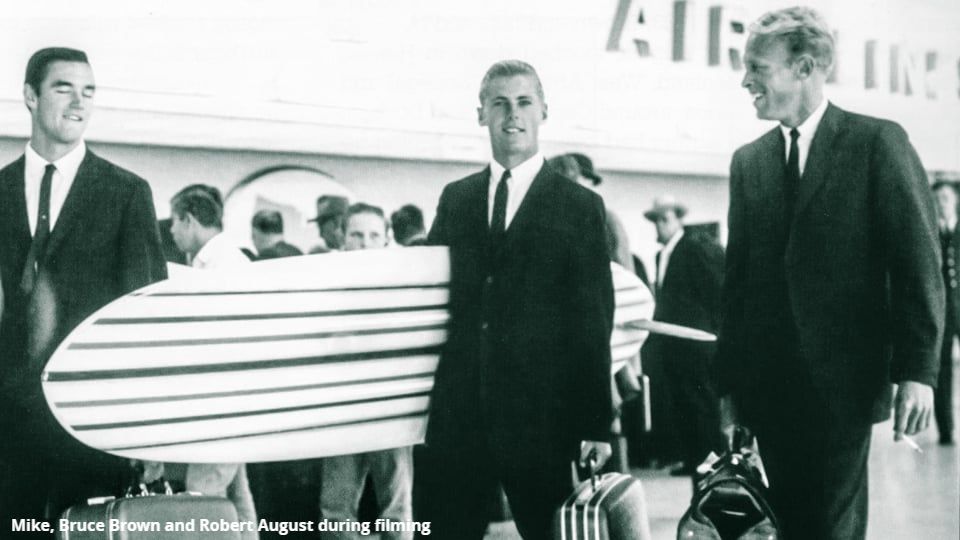
The surfing world recently bid farewell to one of its most enigmatic and influential figures, Mike Hynson, who passed away on January 10, 2025, at the age of 82. Hynson, immortalized as a co-star in the seminal 1966 documentary “The Endless Summer,” was far more than just a face on the silver screen; he was an archetype of the footloose rebel surfer, whose life was a complex tapestry of athletic prowess, countercultural exploration, personal struggle, and enduring artistic contribution. His death in Encinitas, California, marked the end of an era for many who followed the sport, yet his legacy, spanning from pristine waves to the turbulent currents of 1960s social change, remains indelibly etched.
Hynson’s impact extended beyond his captivating on-screen presence, shaping the very aesthetic and philosophy of modern surfing. He was a pioneer in surfboard design, an innovator who pushed the boundaries of wave riding, and a trendsetter whose distinctive style influenced a generation. His journey, from a young man seeking to escape military service to an international surf icon, and then through periods of profound personal challenge, reflects a life lived with an intensity that few could match. This article endeavors to explore the multifaceted existence of Michael Lear Hynson, celebrating his contributions and examining the indelible mark he left on the world.
His story is a narrative arc of a life fully lived, one that encompassed the sublime beauty of the ocean and the turbulent introspection of the human spirit. Through his legendary exploits and his candid reflections, Hynson provided a window into the evolution of surfing from a niche subculture to a global phenomenon, while also offering a poignant commentary on the ephemeral nature of fame and the relentless human quest for meaning. As we recount the early chapters of his remarkable life, we aim to capture the essence of a man who truly embodied the spirit of the endless summer.

1. **Early Life and Genesis of a Surfer:** Michael Lear Hynson was born on June 28, 1942, in Crescent City, northern California. His early years were characterized by a peripatetic existence, a consequence of his father, Robert Hynson, serving as a U.S. Navy engineer. The family’s frequent relocations between naval bases in San Diego and Hawaii provided the young Mike with an unparalleled introduction to the sun, sea, and surf that would define his life’s trajectory. This constant movement instilled in him a foundational connection to the ocean, fostering a nascent passion for wave riding that would soon blossom into a defining skill.
Life near Honolulu, however, was not without its darker moments. A particular incident during his youth saw him trespassing in a neighborhood near the military compound, resulting in a group of local boys stripping him naked, tying him to a tree, and leaving him vulnerable to mosquitoes. Such experiences, while harrowing, perhaps contributed to the maverick spirit that would become a hallmark of his persona, forging a resilience and an independent streak early in his development.
By the time the family finally settled in Southern California when he was 10, Hynson was already deeply immersed in the burgeoning surf culture. He quickly became part of a crew known as the Sultans, honing his skills on the waves around San Diego. His local knowledge and innate talent soon earned him a formidable reputation among his peers, laying the groundwork for his future as a celebrated figure in the surfing world.

2. **Dodging the Draft and the Call of “The Endless Summer”:** After graduating from La Jolla High School in San Diego, Hynson found himself at a pivotal crossroads, confronted with the looming specter of the Vietnam War draft. He had, by his own admission, been “sidestepping them for three years,” a testament to his independent spirit and aversion to conventional authority. The prospect of military service, particularly being sent to fight in Vietnam, was deeply unappealing to the young surfer.
It was at this critical juncture in 1963 that a fortuitous opportunity presented itself. Bruce Brown, a filmmaker friend with whom Hynson had previously collaborated on shorter projects, approached him with a proposition: a leading role in a feature-length documentary. This film, which would ultimately become “The Endless Summer,” offered an unexpected escape route from the draft and an enticing adventure around the world in search of the perfect wave. Hynson embraced this chance, seeing it as the “miracle I needed.”
His upbringing in Hawaii would later prove instrumental in formally dodging the draft. During a psychiatric assessment, Hynson reportedly delivered a rant in which he insisted that his Hawaiian upbringing made it impossible for him to harm Asians, a claim that resulted in him being placed on stand-by rather than being conscripted. This episode further highlighted his unconventional approach to life and his ability to navigate difficult circumstances on his own terms.

3. **The Global Quest for the Perfect Wave:** With the role secured, albeit requiring him to pay his own airfare — a sum of $1,400, no small matter given previous encounters with his boss over stolen surfboards — Hynson embarked on an extraordinary adventure. The journey, alongside fellow surfer Robert August, was a months-long odyssey that took them from California across various hemispheres, ensuring the summer would indeed seem “never ending.”
Their itinerary was a dream for any surf enthusiast: Senegal, Ghana, Nigeria, South Africa, Australia, New Zealand, Tahiti, and Hawaii. This groundbreaking expedition aimed to capture the essence of surfing, its reverential attitude towards the ocean, and the pursuit of unspoiled, flawless waves. The limited budget meant the experience was raw and authentic, far from a luxurious film production, adding to its genuine appeal.
Hynson, with his slicked-back blond hair and distinctive style, became an avatar of Californian cool, riding the waves with August. Their contrasting personalities — Hynson’s callow insouciance and independent thought versus August’s more conventional demeanor — exemplified the emerging surf culture that director Bruce Brown’s film would catapult into the mainstream, challenging prevailing pop culture portrayals of surfing as merely frivolous.

4. **Discovery at Cape St. Francis:** The climax of their global quest, and arguably the most famous sequence of “The Endless Summer,” unfolded at Cape St. Francis near Port Elizabeth (now Gqeberha) in South Africa. It was there, amidst an unspoiled beach, that Hynson and August discovered an expanse of flawless waves, a “perfect reeling right-hander, without a surfer in sight,” as Surfer magazine later described it. This moment epitomized the film’s central theme: the elusive, perfect wave.
Hynson’s recollection of the discovery was visceral and electric. He recalled being awake at 5:00 AM, long before Brown and August, and spotting the unreal waves. “I watched and watched until I couldn’t stand it anymore,” he told surf journalist Scott Hulet in 1991, “then I started screaming and woke everybody up. They were tired, didn’t want to be hassled, but I knew this was it!” His insistence, despite the initial irritation of his colleagues, led them to the iconic spot.
The sheer quality and length of the rides at Cape St. Francis were astounding. Bruce Brown, in his narration, noted that the waves “looked like they had been made by some kind of a machine. The rides were so long I couldn’t get them on one piece of film.” Hynson himself described the experience in his autobiography, “Transcendental Memories of a Surf Rebel,” stating, “I haven’t had too many adrenaline rushes like that in my life, a pure and natural phenomenon. It was electrical. The hair on my neck stood straight up.”

5. **The Untold Challenges Behind the Scenes:** While “The Endless Summer” presented a sun-kissed, idyllic travelogue, the reality behind the cameras was often more complex and fraught with tension. The pristine beauty of Cape St. Francis, for instance, belied waters that “teemed with sharks,” adding an element of danger to their pursuit of the perfect wave. Beyond environmental hazards, personality clashes simmered, particularly between Hynson, described as an “enthusiastic tester of unlicensed substances,” and his more conventional film colleagues.
Hynson’s penchant for independent thought and his early embrace of substances created friction. He later admitted to bringing along a “stash of amphetamines and a three-month supply of Tijuana marijuana,” confessing, “I was young, stupid and loaded.” This clandestine aspect of his journey added a layer of rebelliousness that was not overtly shown in the family-friendly documentary but was very much a part of his reality.
Another notable challenge arose during a layover in Bombay (now Mumbai), India. Fearing that their precious 16mm film footage, particularly of the iconic Cape St. Francis waves, would be confiscated by rumored capricious Indian customs agents, Hynson took matters into his own hands. In a desperate move, a terrified Hynson taped 16mm cartridges to his ribs, smuggling them past the authorities and resisting a “desperate urge to scratch the itches under his Hawaiian shirt.” This act underscored the raw, improvisational nature of the production and Hynson’s pivotal, if unconventional, role in preserving the film’s most crucial scenes.

6. **”The Endless Summer” Takes the World by Storm:** Shot in 1963, the same year The Beach Boys recorded “Surfin’ USA,” “The Endless Summer” faced an uphill battle for recognition. Initial distributors showed little interest, with Warner Bros. reportedly predicting it “would never go beyond 10 miles from the beach.” Yet, director Bruce Brown persevered, proving them wrong with a pivotal winter test screening in the landlocked and frigid city of Wichita, Kansas, where the film surprisingly delighted moviegoers, drawing lines around the block even during a snowstorm.
Released across the United States in 1966 after a prolonged search for a distributor, “The Endless Summer” became an instant smash hit. Costing a mere $50,000 to produce, it went on to gross an astonishing $30 million. The film not only made Brown rich but also introduced the sport of surfing to millions of new fans in the United States and globally, cementing its place as a cultural touchstone and a definitive portrayal of the surfing lifestyle.
For Hynson, however, the film’s immense financial success did not translate into personal wealth. “I got the fame. The fortune went somewhere else. Someone else was thinking about that,” he remarked in a 2007 interview. Despite this disparity, Hynson remained “untroubled by self-doubt,” widely admired even if “not universally liked.” He had achieved celebrity status, his image becoming synonymous with the emerging surf culture, a legacy that would continue to shape his life for decades to come.




